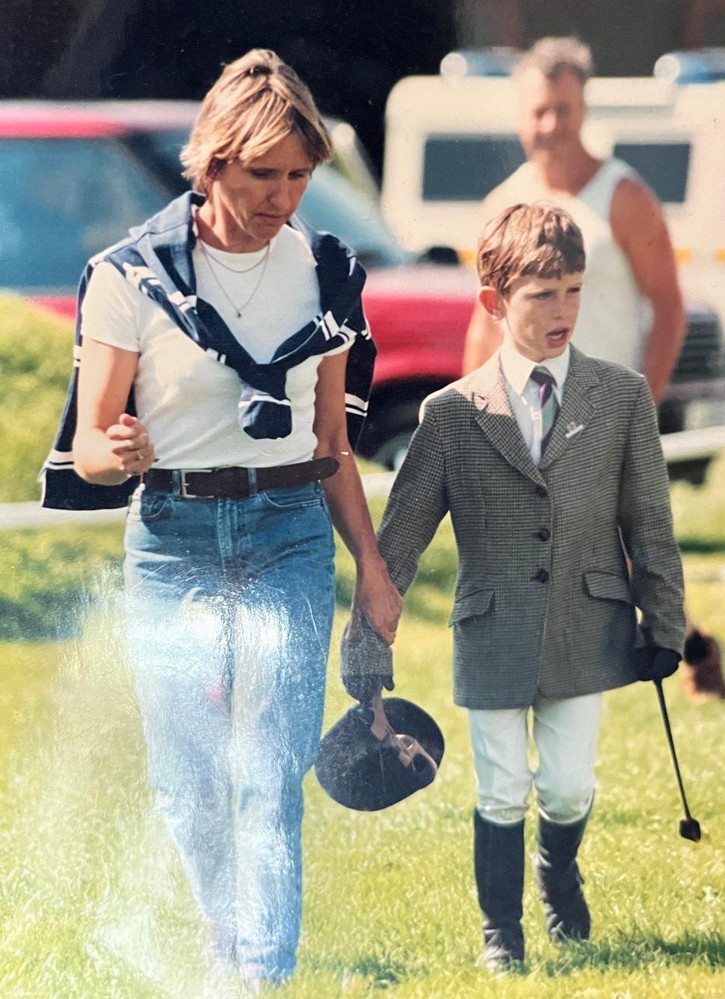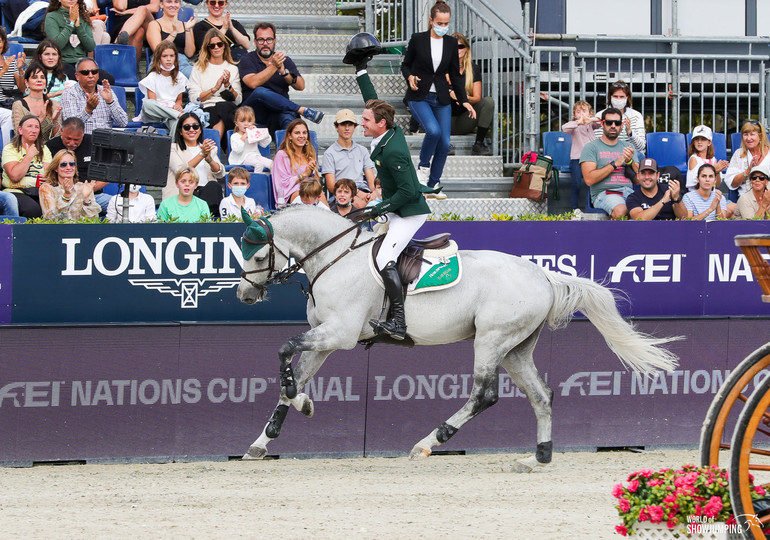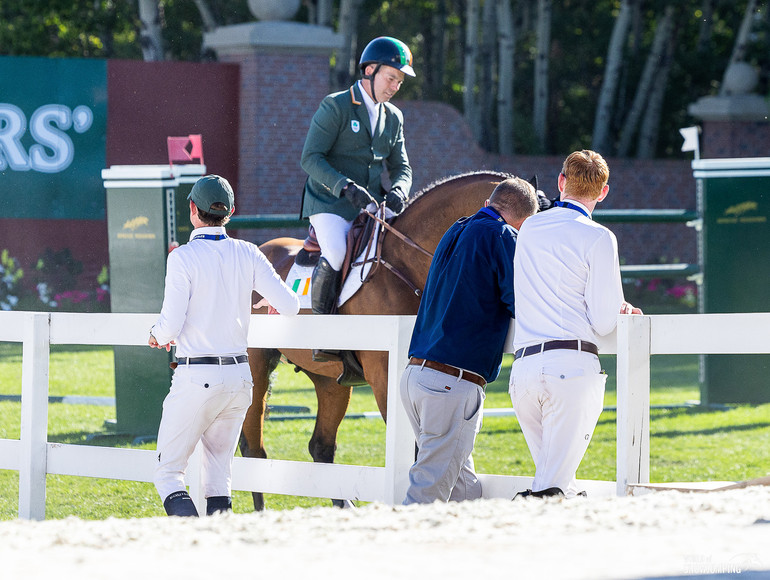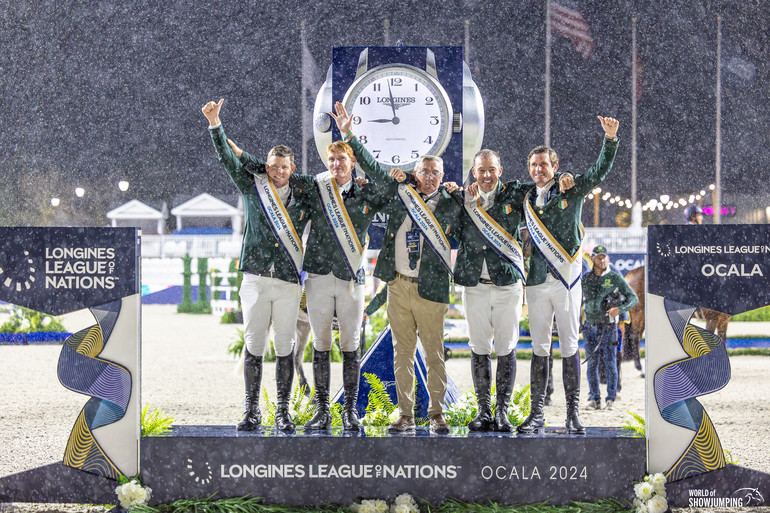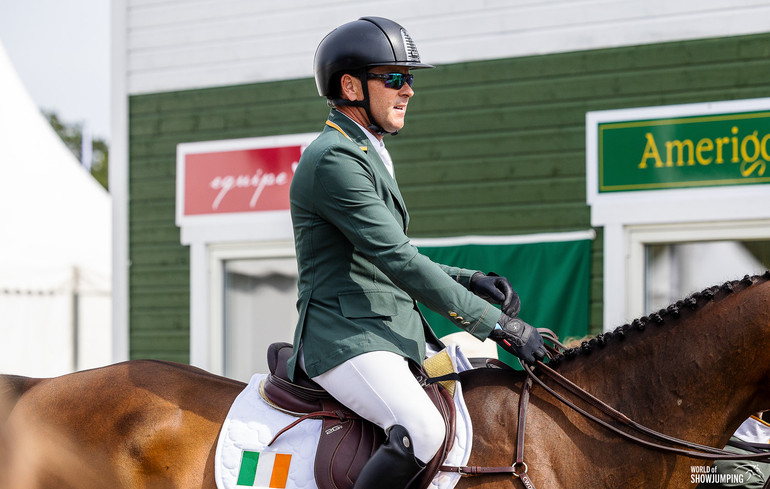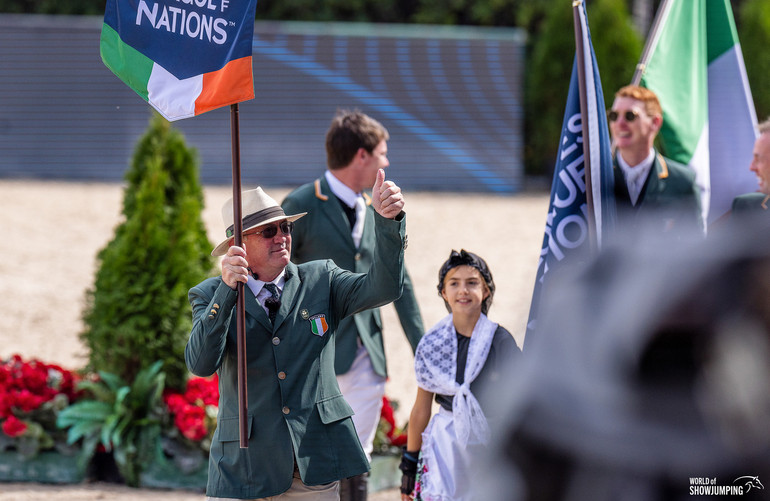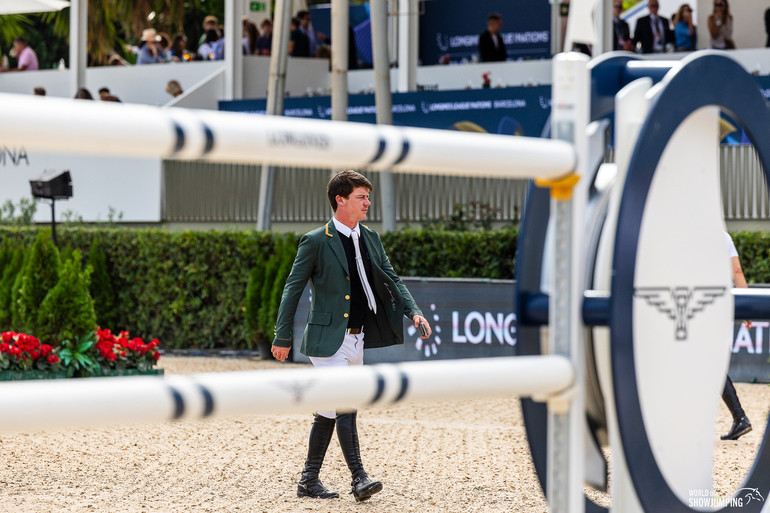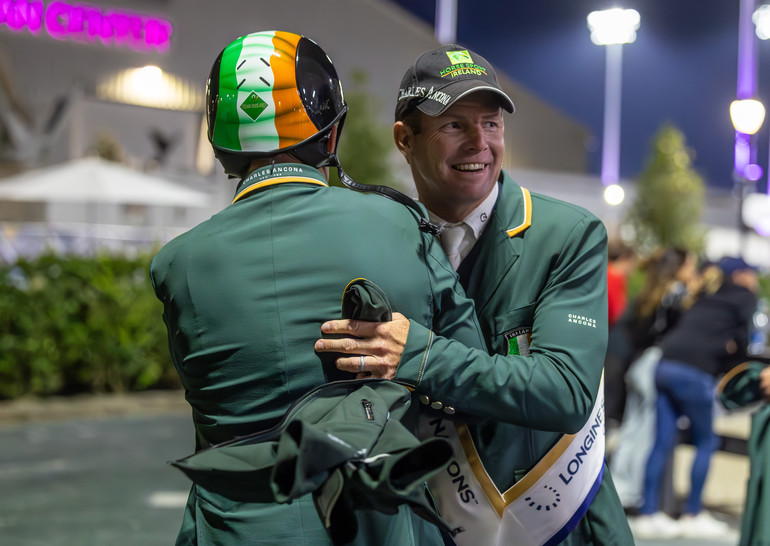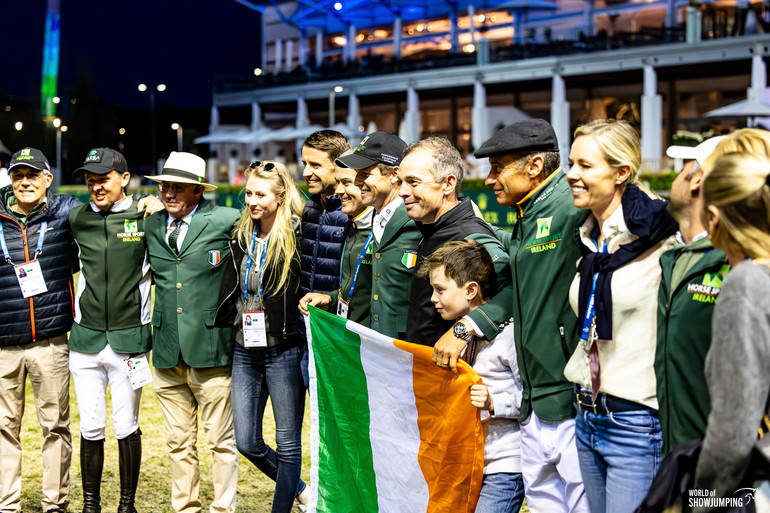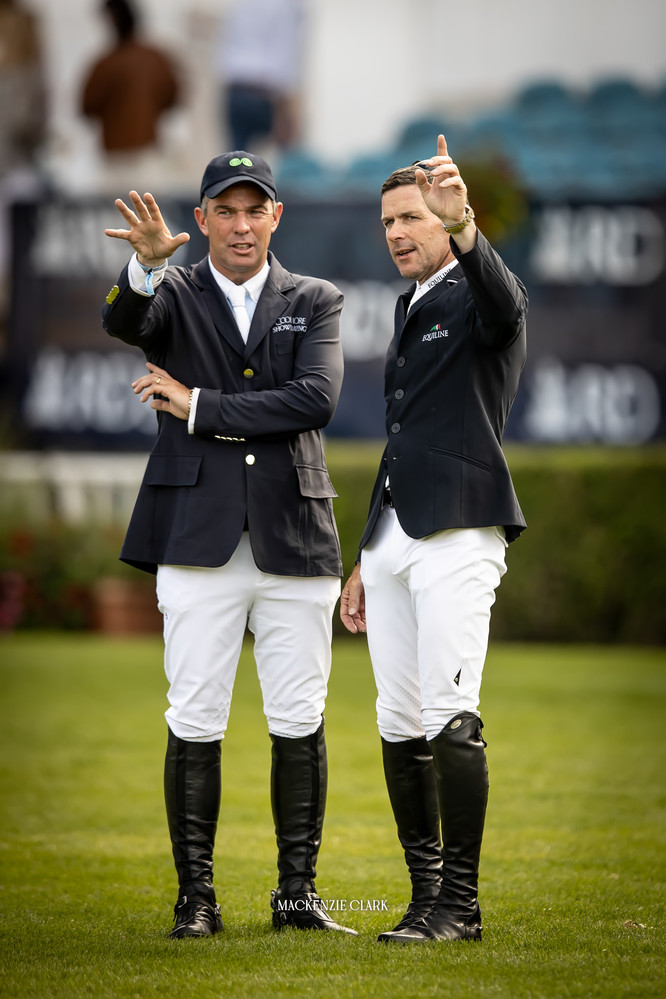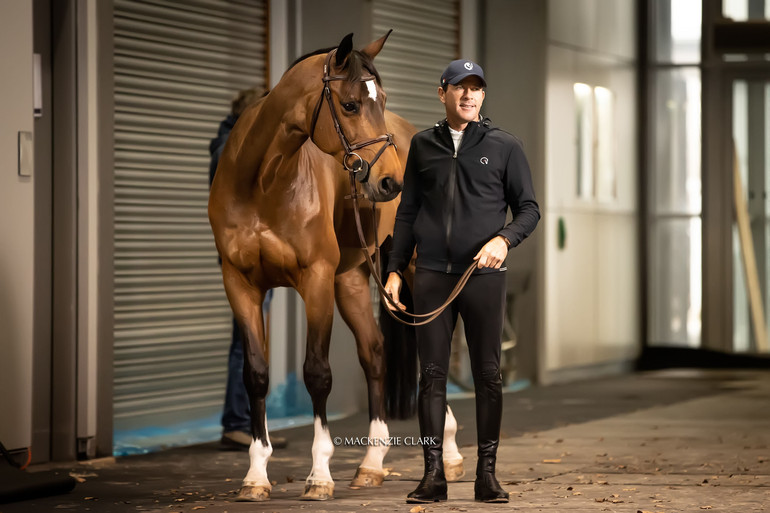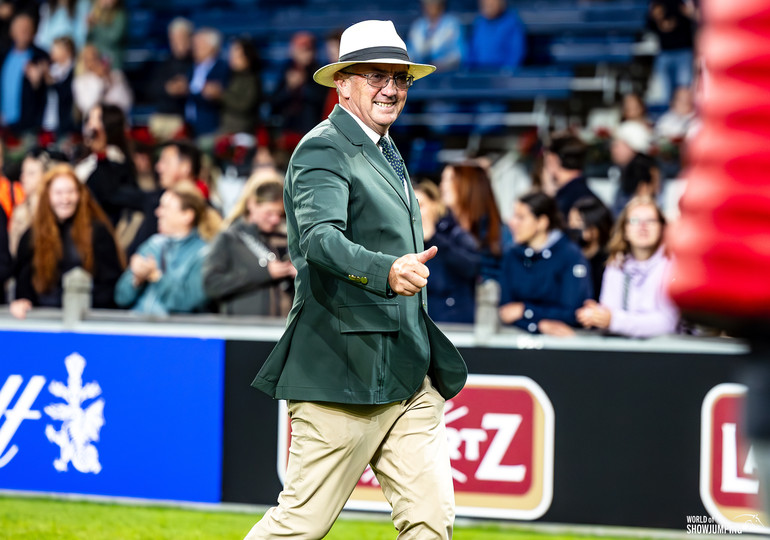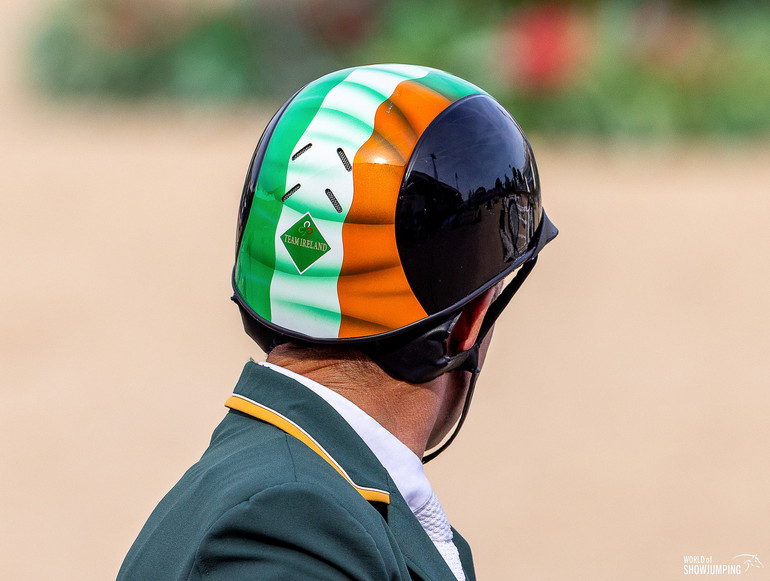 “We punch above our weight for a small island of riders, and obviously everyone knows that Ireland is synonymous with the horse,” Cian O’Connor says to World of Showjumping. “Many countries are bigger breeders of horses than we are, but they don't have the same success. So that begs the question, why and how are the Irish so good, and how are they constantly churning out these talented riders?”. Photo © Jenny Abrahamsson/World of Showjumping.
“We punch above our weight for a small island of riders, and obviously everyone knows that Ireland is synonymous with the horse,” Cian O’Connor says to World of Showjumping. “Many countries are bigger breeders of horses than we are, but they don't have the same success. So that begs the question, why and how are the Irish so good, and how are they constantly churning out these talented riders?”. Photo © Jenny Abrahamsson/World of Showjumping.
Text © World of Showjumping
Ranked as the best showjumping nation in the world on FEI’s Longines League of Nations™ Ranking for two consecutive years, Ireland currently boasts seven riders within the top fifty on the Longines Ranking [N° 286] and six riders in the top fifty on the FEI U25 Ranking [N° 70].
During 2024, Ireland has been on more five-star Nations Cup podiums than any other country – eight times in total. On two of those eight podiums the Irish stepped to the top, including the most prestigious of them all – at the Mercedes-Benz Nations Cup at CHIO Aachen. Additionally, the Irish have had another seven senior Nations Cup podium finishes spread out across three- and four-star level in 2024. Furthermore, Irish riders have podiumed in 30 Grand Prix and World Cup classes at five-star level this year, winning eleven of them [Editor's note: Data from EquiRatings].
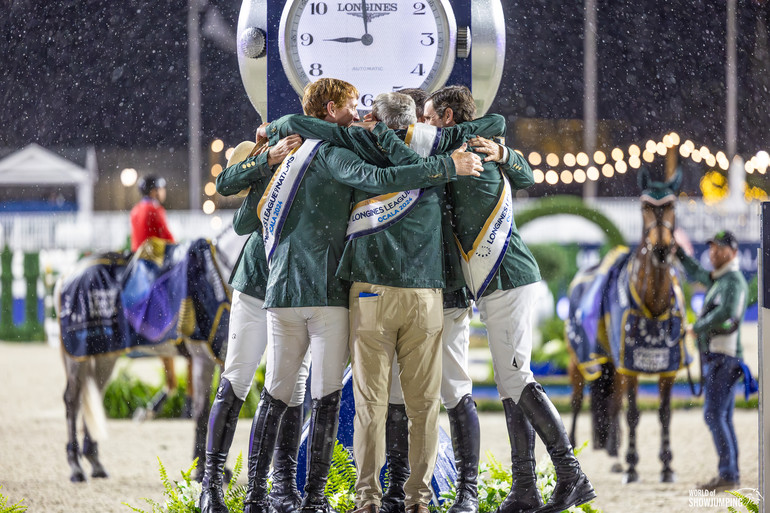 Ranked as the best showjumping nation in the world on FEI’s Longines League of Nations™ Ranking for two consecutive years, Ireland currently boasts seven riders within the top fifty on the Longines Ranking and six riders in the top fifty on the FEI U25 Ranking. Photo © Jenny Abrahamsson/World of Showjumping.
Ranked as the best showjumping nation in the world on FEI’s Longines League of Nations™ Ranking for two consecutive years, Ireland currently boasts seven riders within the top fifty on the Longines Ranking and six riders in the top fifty on the FEI U25 Ranking. Photo © Jenny Abrahamsson/World of Showjumping.
For a country considerably smaller in terms of FEI registered athletes and horses when compared to other nations such as France, Germany, Great Britain and the U.S., the Irish results are impressive. While Ireland has 784 athletes and 1772 horses registered with the FEI, France – in comparison – has 5540 athletes and 11246 horses, followed by Germany that has 3638 athletes and 8783 horses. Nonetheless, a country such as France has three less riders than Ireland both in the top fifty of the Longines Ranking [N° 286] and the FEI U25 Ranking [N° 70]. Notably, Germany does not have a single rider within the top fifty on the FEI U25 Ranking [N° 70].
“We punch above our weight for a small island of riders, and obviously everyone knows that Ireland is synonymous with the horse,” Cian O’Connor says to World of Showjumping. “Many countries are bigger breeders of horses than we are, but they don't have the same success. So that begs the question, why and how are the Irish so good, and how are they constantly churning out these talented riders?”
A real horse country
“The first thing that I would go to is that Ireland really is a horse country,” Darragh Kenny (36) – currently ranked 19th in the world – begins. “Even from a young age, most people have interactions with horses and if you want to learn how to ride it’s actually quite easy access.”
“Personally – and I think this goes for many Irish riders – the horses have been a very family-oriented activity,” Kenny says. “My parents had horses even before I was born. I grew up with horses, and my parents gave me a great education when I was young and tried to always have other trainers around to help. There’s been a lot of support in that sense.”
If you want to learn how to ride it’s actually quite easy access
- Darragh Kenny -
“In Ireland, there is also lot of breeding, and we produce a lot of young horses. The result is that as a young rider in Ireland you really get to work with a lot of different horses, but mostly it's younger horses,” Kenny continues. “So, I think already as juniors and young riders we learn a lot about producing horses correctly and properly – which serves us well later on. It gives a strong foundation for the younger riders to fall back on, and I think that knowing how to produce a horse is something that helps give structure to succeed and staying at a high level.”
I think that knowing how to produce a horse is something that helps give structure to succeed and staying at a high level
- Darragh Kenny -
“I think one of the main reasons that there are so many good Irish riders is that many kids – like myself – start to ride right from the beginning,” Conor Swail (53) – currently world no. 10 and the highest ranked Irish rider globally – says. “I have been riding since I was 5-6 years old and got started with the pony jumping very early on. The ponies provide a lot of experience and teach you to be competitive from a young age. Personally, I think that played a big part in my own career.”
“Originally, my own family had nothing to do with horses,” Swail tells. “My dad was a plasterer, but he worked for a builder who had a lot of horses. They became good friends, and he gifted my dad a horse. My dad started to ride as a hobby, and my brother Marcus and I became interested and also began riding. After a while, we got a few ponies for ourselves, and that’s how it all started.”
From seat-of-the-pants to a standardized system of riding
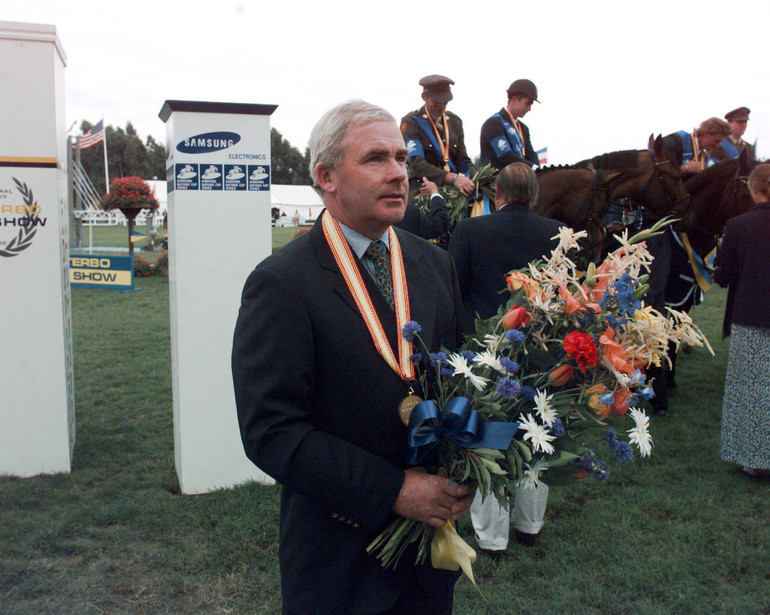 "I’m maybe a little bit biased, because when I look back at how I was educated by Gerry Mullins there was definitely a system in his coaching – and it’s since been used in many countries within the FEI through the Coach Education System that Gerry was a part of developing," Cian O'Connor tells. Photo © Roland Thunholm.
"I’m maybe a little bit biased, because when I look back at how I was educated by Gerry Mullins there was definitely a system in his coaching – and it’s since been used in many countries within the FEI through the Coach Education System that Gerry was a part of developing," Cian O'Connor tells. Photo © Roland Thunholm.
“In the past, it’s fair to say that Irish riders were seen as kind of natural, seat-of-the-pants, learning to ride going across the fields in Ireland,” Cian O’Connor (45) – a mainstay on the Irish team for the last 20 years – says. “Traditionally, the Irish weren't known for their flatwork, they were just natural talents. I think that when the coaching came in, we were able to combine that natural talent with both the education and knowledge of how to actually produce a horse, how to get a horse going better and also how to manage a good horse.”
“I would say that throughout the last twenty years, coaching became a big thing in Ireland and a standardized system of riding has developed within our country,” O’Connor says. “I think that through many people's influence, helped by the Army Equitation School and in particular Gerry Mullins’ coaching syllabus, there became some form of a structured system of teaching and training which many follow today. I’m maybe a little bit biased, because when I look back at how I was educated by Mullins there was definitely a system in his coaching – and it’s since been used in many countries within the FEI through the Coach Education System that Gerry was a part of developing.”
Through many people's influence, helped by the Army Equitation School and in particular Gerry Mullins’ coaching syllabus, there became some form of a structured system of teaching and training
- Cian O'Connor -
“As a result of the structured system of coaching that was being rolled out at the time, these different training clinics developed all over Ireland. Showjumping Ireland – a very good national organization – would give us younger riders bursaries so we could attend,” O’Connor continues.
“The result today is that overall, there is a common theme of correct education of the horse, and correct education of the rider,” O’Connor says. “If you go to a show today – whether it's the FEI WBFSH Jumping World Breeding Championships for Young Horses, the European Championships for juniors or ponies, or a senior Nations Cup – and look to the Irish riders, you will see that there is a systematic approach. You can really spot the Irish, and I think that largely has come through from combing talent with coaching – giving you the ultimate package.”
Bursaries and education of the youth
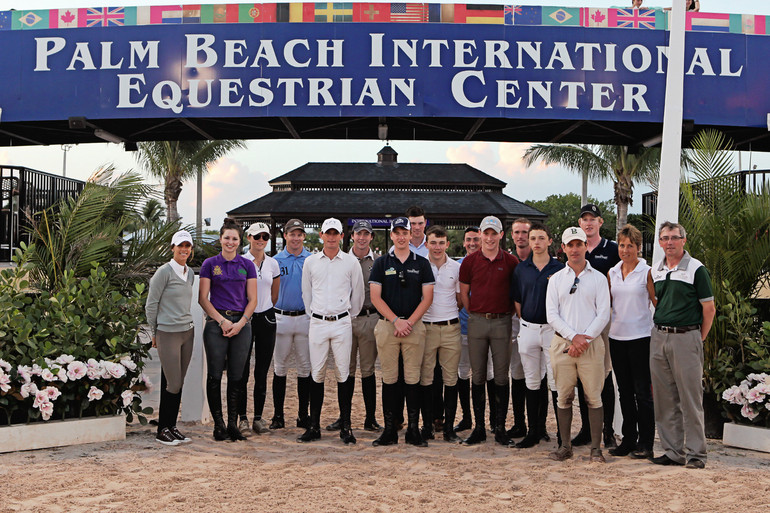 "I would tell them to put a photo of a miserable, rainy Irish day at the end of their beds, so when they woke up in the morning the first thing they would see was that and they would only want to go back home for Christmas,” Michael Blake laughs as he tells about the bursary system which helped many younger Irish riders go to the U.S.. Photo © Lexey Hall Photography.
"I would tell them to put a photo of a miserable, rainy Irish day at the end of their beds, so when they woke up in the morning the first thing they would see was that and they would only want to go back home for Christmas,” Michael Blake laughs as he tells about the bursary system which helped many younger Irish riders go to the U.S.. Photo © Lexey Hall Photography.
“Back in 2013, myself, Maureen Bagnall and Tomas Ryan acknowledged that we didn’t have enough horsepower among our younger riders, so we were swimming around in the same circle in this small pool – not achieving anything,” Michael Blake – High-Performance Jumping Director at Horse Sport Ireland since the end of 2019 – tells, as he brings us closer to the last decade. “We had great senior riders at the time – Cian, Conor, Darragh, Denis, Shane – but nothing to back them up with.”
“We decided to create a bursary system where we could send up to ten of our younger riders to America or Europe on an annual basis,” Blake continues. “This was made possible by sponsorship from Horse Sport Ireland and Red Mills horse feeds. We sent the likes of the two Michael Duffys, Michael Pender and Eoin McMahon out of Ireland – normally it was for around three weeks. My advice to them would be to make themselves invaluable. I would tell them to put a photo of a miserable, rainy Irish day at the end of their beds, so when they woke up in the morning the first thing they would see was that and they would only want to go back home for Christmas,” he laughs.
We decided to create a bursary system where we could send up to ten of our younger riders to America or Europe on an annual basis
- Michael Blake -
“You will still see that today there are a lot of riders in the younger generation being paired up with someone more experienced,” Kenny – who himself received a bursary to go to the States at the age of 16 – tells about the systematic Irish approach. “Francis Derwin and Stephen Moore are with me, Alice, Max and Tom Wachman are with Cian, Niamh McEvoy works for Greg Broderick, Mikey Pender is with Marion Hughes, and Richard Howley always takes on a younger Irish rider too. That kind of approach seems to help the whole system grow well. Some of these opportunities are made possible through bursaries, as initiated by Michael Blake, and it really helps the younger kids to go different places that weren't available 15-20 years ago. A lot of the riders in the older generation are willing to help the younger ones, which creates opportunities.”
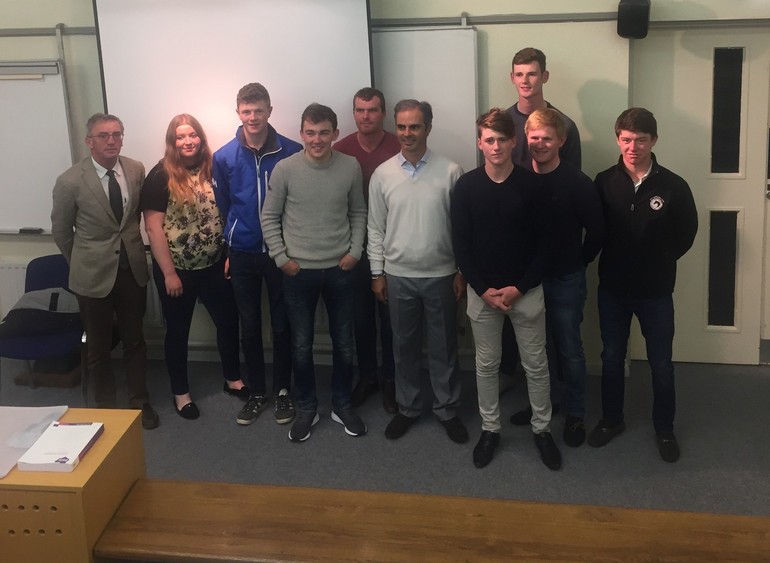 In 2017, Michael Blake, Maureen Bagnall and Tomas Ryan initiated an educational academy for the younger Irish riders. Here Rodrigo Pessoa pays a visit. "Looking back, I believe it was beneficial for the Irish riders – until now we have had eighteen riders selected for the Rolex Young Riders Academy, a big number for a small nation," Michael Blake says. Photo © private collection.
In 2017, Michael Blake, Maureen Bagnall and Tomas Ryan initiated an educational academy for the younger Irish riders. Here Rodrigo Pessoa pays a visit. "Looking back, I believe it was beneficial for the Irish riders – until now we have had eighteen riders selected for the Rolex Young Riders Academy, a big number for a small nation," Michael Blake says. Photo © private collection.
“The second initiative we launched to try to improve the situation was an educational academy that the younger riders based in Ireland had to attend,” Blake explains. “It was introduced in 2017, and together with the bursary system it aligned well with the Rolex Young Riders Academy which was launched in 2014. Through our own Irish academy, the riders had already done their homework – they had been taught about everything from horsemanship and horse welfare, to accounting and media management. Looking back, I believe it was beneficial for the Irish riders – until now we have had eighteen riders selected for the Rolex Young Riders Academy, a big number for a small nation. Bertram Allen, Eoin McMahon and Michael Pender are just some of the Irish Nations Cup riders that have come through the Rolex Young Riders Academy,” Blake points out.
A hunger to learn
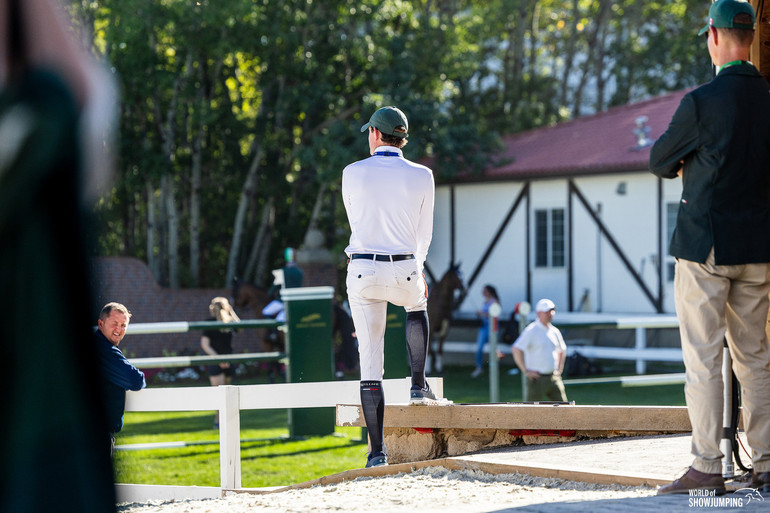 “When I grew up in Ireland, there were some really, really good riders like Conor Swail and Carl Hanley – these correct, stylish, talented riders – based there,” Darragh Kenny tells. “And so, when I was 10-11-12 years old, these were the guys I was watching." Photo © Jenny Abrahamsson/World of Showjumping.
“When I grew up in Ireland, there were some really, really good riders like Conor Swail and Carl Hanley – these correct, stylish, talented riders – based there,” Darragh Kenny tells. “And so, when I was 10-11-12 years old, these were the guys I was watching." Photo © Jenny Abrahamsson/World of Showjumping.
While the Irish youth today benefits from more structured education, and an overall strategy aimed at pairing them with the more experienced generation, a rider like Swail – who grew up in the 1970s and 80s – is completely self-taught. “Personally, I never had anybody help me or anybody train me,” Swail tells. “But I would watch the likes of Eddie Macken and learn this way; I simply tried to ride like the best riders. I had to figure it out myself and I learned by doing.”
In his turn, Kenny would look to Swail – who is 17 years older than him. “When I grew up in Ireland, there were some really, really good riders like Conor Swail and Carl Hanley – these correct, stylish, talented riders – based there,” Kenny adds. “And so, when I was 10-11-12 years old, these were the guys I was watching, and I learned how to do things in a really correct way; how to ride properly and how to correctly school a horse on the flat. Those are things that are really important.”
In Ireland, there's a great hunger amongst people to learn from others
- Cian O'Connor -
“In Ireland, there's a great hunger amongst people to learn from others and when there's someone successful at a high level, young riders are looking to them, saying ‘how can I do that?’” O’Connor points out. “There is a curiosity to improve through learning from others.”
“I also suppose there is a mentality where everyone recognizes that you learn from your mistakes as well,” O’Connor continues. “I think that's a good thing about our team manager Michael Blake; he doesn't hold a bad round or a bad day against you. You know, I heard an interview recently with Richard Vogel and when you look at him, how well he's doing – in order to pull off these miracle jump-offs, he's had as many or more that didn't work out for him. And that kind of idea of not being afraid to have a go really resonates with all of us; if you make a mess, you try again.”
Strong work ethics
“I also think that as Irish riders we learn from a young age that this business is a tough business and it's hard work,” Kenny points out about another key factor in the Irish riders’ success. “And that if you want to succeed and you work hard, you will succeed. And if you don't work hard, you won't succeed.”
“I also think that the lack of financial strength in Ireland back in my days probably helped because it made us realize that we couldn't just go out and buy something. If we wanted to make it to a high level, we had to produce the horses ourselves,” Kenny says.
“The Irish know how to work because many of us were born with not so much,” Blake fills in. “So, I suppose when the Irish riders get an opportunity, they know the value of that opportunity and they also know the value of money because they all had to work for it.”
As Irish riders we learn from a young age that this business is a tough business and it's hard work
- Darragh Kenny -
“We could not afford much,” Swail says looking back. “We had a little truck with a small self-made living that my dad had built himself, which would get us and our ponies to the shows.”
“When I transitioned to the juniors, it became more difficult financially – we could not afford to buy a horse,” Swail tells. “At that point I was finishing up school, so the question was whether I should get a real job or do the horses. I decided to give the horses a go and started up my own little yard just across the road from my home; there was a little old house that we converted into stables. As time went by, I would take in horses to train, and to break in – and it developed from there. Gradually I would start to buy and sell, and get better horses. There was never anything given to me though, I had to work to make ends meet.”
There was never anything given to me, I had to work to make ends meet
- Conor Swail-
“Many of the horses I rode back then, I would never sit on today – I had no fear at all,” Swail laughs. “Obviously, I would not do it now, but when I was younger, it was just fun to take on these horses that had a lot of spirit and some of them had also had bad experiences that I tried to help them overcome. However, these horses taught me so much and they gave me a lot of information that I learned from. I believe that this experience made me very good at understanding the horses and get the best out of them, which has served me well later in my career.”
“I'd say there's a strong work ethic among the Irish, but I think anybody who's successful in horses has to have that because there's so many down days and you have to be able to pull yourself up and look at the bright side,” O’Connor says. “You have to be able to reinvent yourself and move on to the next thing; that’s a real sign of success, you know. When it's going well that's great, but you have to be prepared for when it's not going well – how do you deal with that? And I think the Irish are particularly resilient.”
A man with a plan
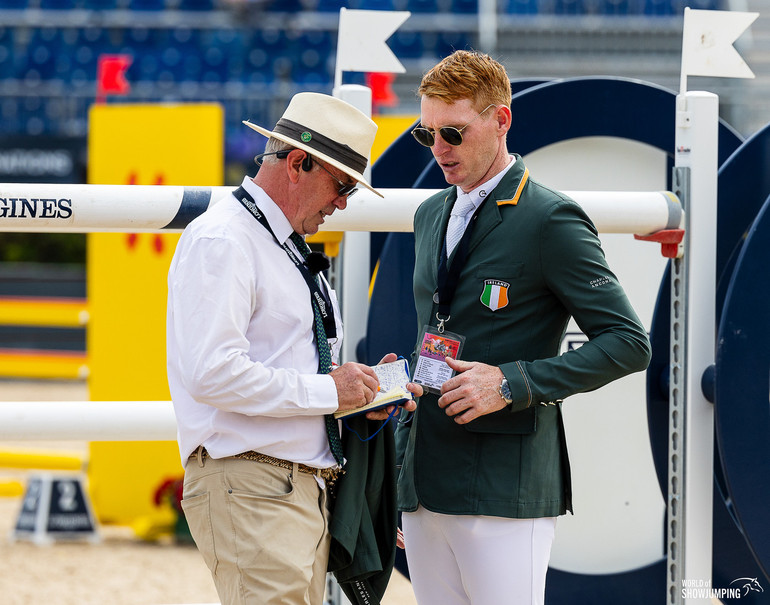 “The influence that Michael has had on the Irish team, particularly back when he worked with the juniors and the young riders together with John Ledingham before he then took over the senior team from Rodrigo, has been paramount to the success we have today,” Cian O’Connor tells. Photo © Jenny Abrahamsson/World of Showjumping.
“The influence that Michael has had on the Irish team, particularly back when he worked with the juniors and the young riders together with John Ledingham before he then took over the senior team from Rodrigo, has been paramount to the success we have today,” Cian O’Connor tells. Photo © Jenny Abrahamsson/World of Showjumping.
“I have to say that I think Michael Blake also has had a huge influence on where we are at as a showjumping nation internationally,” Kenny points out. “When Michael succeeded Rodrigo Pessoa as High-Performance Jumping Director in 2019, the first thing he did was to ask for an invitation for every single Nations Cup. No matter what the level was, Michael wanted to have a team at every show, and he wanted to give young riders a chance to go in a Nations Cup.”
“Michael has made a huge effort to do that, which then in turn helped a lot of the young riders that maybe wouldn't have gotten out of Ireland at that time,” Kenny continues. “That got them to international shows abroad, got them to a higher level and showed them what it took to be there. Previously, there were sometimes people in Ireland who were a little bit delusional as to what they had – many thought they had a Grand Prix horse when it was jumping a 1.40m Grand Prix in Ireland, and they didn't know that a CSI3* Grand Prix at 1.55m was much different. Whereas now, everybody really gets it. They know what it takes to be at the highest level, because they have had the opportunities to see it which makes everyone push to become better.”
No matter what the level was, Michael wanted to have a team at every show, and he wanted to give young riders a chance to go in a Nations Cup
- Darragh Kenny -
“The influence that Michael has had on the Irish team, particularly back when he worked with the juniors and the young riders together with John Ledingham before he then took over the senior team from Rodrigo, has been paramount to the success we have today,” O’Connor says. “Michael has always given young people a chance. He's never afraid to go against the grain and give the younger fellas an opportunity. And I think by bringing in new blood all the time, which he does, it creates a vibe that I suppose keeps all of us motivated. The young guys coming on push us older riders, because when you're surrounded by young people you strive to do better yourself. The fearlessness of them is motivating, and you want to beat them – but in a good way.”
“In Ireland, we also take Nations Cups seriously,” O’Connor says. “I think some of the other countries find it hard to get riders to line out, but the Irish really want to ride on the team. That kind of culture where riders are pushing to jump on the team is a healthy one. If nobody was wanting to go, and Michael was just selecting whoever was the last man standing we probably wouldn't do as well. But when we're all trying our best and we all want to jump on the team, I think that's a great sign. That's why Team Ireland is so successful.”
“I think that currently we have very good riders and also a little bit more horsepower than in the past. We have experienced riders like Cian, Daniel, Darragh, Denis and Shane, some of them with some of the best horses in the world like Legacy and James Kann Cruz,” Swail says. “Any of those guys you would like on your team; they do an amazing job every time and they are always cool. Additionally, Ireland is also very competitive at the youth levels and there are so many good younger riders on the way up.”
“We have very consciously tried to emphasise blending experienced senior riders with up-and-coming talent,” Blake himself says. “By now we have depth in the team; Ireland boasts 35 senior elite riders to draw from, which creates flexibility in our team selection.”
“In 2024, we only used around 30 different riders because we were focusing a bit more towards the Olympics and we wanted to give the championship riders more chances. We had 15 podium finishes out of 21 starts. But, in 2023, we actually used 39 different riders and we had 13 podium finishes – whereas four were wins – out of 19 starts,” Blake tells.
We have very consciously tried to emphasise blending experienced senior riders with up-and-coming talent
- Michael Blake -
“What I’m also proud of is that when we won last year’s Nations Cup in Rome – for the first time in history – two of the riders that were part of the squad had come through our own academy and three of them had been through the Rolex Young Riders Academy. Paired with the experience of Denis Lynch, Michael G. Duffy, Michael Pender and Jack Ryan went out in Rome and set the record straight. I love these young riders because I suppose I have a long working relationship with them, so that was something very special. To me, it also confirmed my philosophy of how nothing will prepare you for a Nations Cup other than being on a Nations Cup team, and that these mentorships between the seniors and the younger generation are really important,” Blake says.
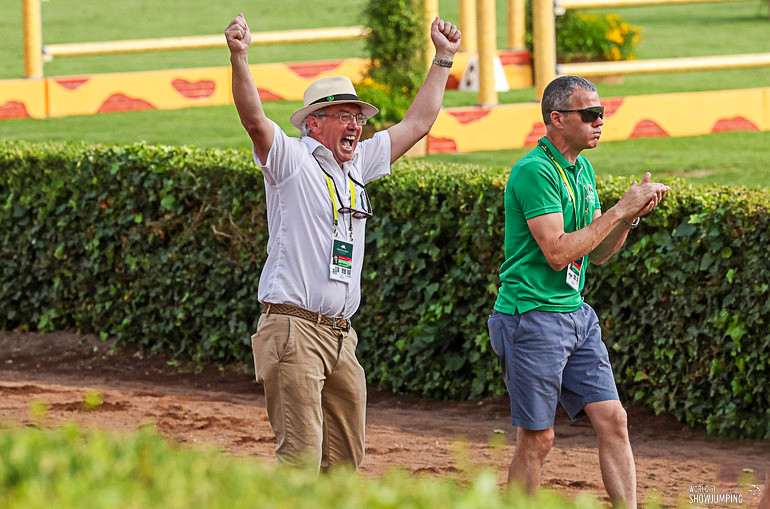 “What I’m also proud of is that when we won last year’s Nations Cup in Rome – for the first time in history – two of the riders that were part of the squad had come through our own academy and three of them had been through the Rolex Young Riders Academy," Michael Blake tells. Photo © Jenny Abrahamsson/World of Showjumping.
“What I’m also proud of is that when we won last year’s Nations Cup in Rome – for the first time in history – two of the riders that were part of the squad had come through our own academy and three of them had been through the Rolex Young Riders Academy," Michael Blake tells. Photo © Jenny Abrahamsson/World of Showjumping.
“I do think we have created a winning culture where you don't put up your hand unless you think you can deliver,” Blake points out. “Everyone who wants to be on the team is putting their best foot forward and are beyond averagely committed. You can't do a Nations Cup on route from one show to another, it’s different to anything else. In 2 1/2 hours you’ll jump two rounds over 14 fences and do the open water twice. Plus, you have the added pressure of jumping for your country.
A supportive team environment
“I think Michael Blake also has had a lot to do with the team environment,” O’Connor says. “Under Michael's guidance, we have been able to come together and put our individual experiences into one unit and I think that's what creates the winning team. We're able to see each other's strengths or weaknesses and we often would advise or help each other. We would never dismiss each other's opinion because we all respect one another as professionals.”
“Showjumping is probably more comparable to golf than other team sports for example, because the majority of the time this is an individual sport,” O’Connor says. "We go to shows like Aachen, Rome and Dublin and out of fifteen classes you would like to beat each other in fourteen. But for that one team class we need the ability to all come together, and we genuinely have that – which makes us strong as a team.”
Under Michael's guidance, we have been able to come together and put our individual experiences into one unit and I think that's what creates the winning team
- Cian O'Connor-
“Over the last 5-6 years, what I have seen on the Irish team is that all of us really want the best for everybody,” Kenny seconds. “We want everybody to be as successful as they can be. We are there trying to help each other, and nobody is going behind each other’s backs – it's become a very positive environment to be a part of.”
“Michael is a very energetic team manager, and he really wants the team to do well,” Swail adds. “And I also think that all the riders have a lot of respect for each other.”
“I strive to foster a spirit of camaraderie, strong work ethic, and a ‘get-it-done’ attitude,” Blake confirms. “I aim to lead myself, our riders, and inspire them to lead themselves as well. This extends to encouraging riders to support and advise each other, fostering a sense of pride and unity."
Many different roads lead to Rome
While Kenny, O’Connor and Swail’s common denominator is that they are all successful at the highest level, their journeys to the top have been different. Kenny left Ireland in 2008, Swail in 2013, while O’Connor has stayed.
“I think it’s definitely an added challenge being based out of Ireland like I do, because you have to cross two seas every time you want to go to the continent for a show,” O’Connor points out about what differs him from many other riders that have left the Emerald Isle. “However, I always took a different view and that wouldn't be unusual for me – I'd probably do the opposite of most people anyway! I felt that if I was based in Eindhoven, I would just be another Irish fellow based in Holland and only a number. By being based at home, I could be the big fish in the small pond. That's the way I viewed it when I was 20 years old, and I never changed that view; it stood me well in terms of my business – customers and clients that I was able to attract by being Irish-based – as well as the support from Horse Sport Ireland.”
By being based at home, I could be the big fish in the small pond
- Cian O'Connor -
For, Kenny and Swail, and more, doors were opened because of their move to the other side of the pond – but it wasn’t necessarily that much easier. “Probably it would have been a bit more difficult to stay in Ireland in terms of being successful,” Swail says. “However, before I left Ireland in 2013, I was still 21st on the world ranking and I had some really good 9-year-old horses at the time so there were also opportunities to make it at home. It would probably just have been a little bit harder. After leaving Lothlorien in 2017 and starting on my own, I have been back to working off a very limited budget, so, as in the past, I still need to focus on making the horses become better over time – that hasn’t changed.”
I would not be where I am at all without going to America
- Darragh Kenny -
“I would not be where I am at all without going to America, and having that support from American owners,” Kenny says. “Conor, Shane [Sweetnam], Daniel [Coyle], and myself – the list goes on – have all been lucky to have some brilliant owners who have supported us really well. A lot of us got opportunities with the help of North American owners, and I do think that has contributed a lot to where we are today. I think owners appreciate that Irish riders are willing to work hard, have quite a positive attitude and we always want to win – those are attributes that seem to work well in the U.S.”
“I suppose securing top quality horses is something that remains a critical challenge, but I have to say the Irish riders excel at getting investors and owners to back them,” Blake says. “And if you look at the horses, there are also many owners outside of Ireland supporting Irish riders – which is very much appreciated by Team Ireland.”
Future visions
“I will continue to focus on developing young riders and U25 riders as a pipeline for senior success,” Blake says about his future visions. "Mentorship between the senior riders and the younger generation will continue to be one of our most important tools in that regard. My vision is for Ireland to continue being one of the best teams in the world. Within that, we focus on specific competitions and work together to build team cohesion.”
Mentorship between the senior riders and the younger generation will continue to be one of our most important tools
- Michael Blake -
“As team manager you need to recognise that beyond the riders, there is a larger team – owners, grooms, staff, farriers, physios, vets, as well as the national federations,” Blake points out. “We work together seamlessly to achieve results. This shared trust, purpose, and belief in the Irish showjumping system has brought everyone on board to work towards the same objective – winning or earning a podium finish."
4.12.2024 No reproduction of any of the content in this article will be accepted without a written permission, all rights reserved © World of Showjumping.com. If copyright violations occur, a penalty fee will apply.



